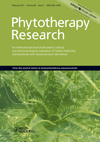The In Vitro Inhibition of Human CYP1A2, CYP2D6 and CYP3A4 by Tetrahydropalmatine, Neferine and Berberine
Abstract
The purpose of this study was to investigate the in vitro inhibition potential of the three purified herbal constituents tetrahydropalmatine (Tet), neferine (Nef) and berberine (Ber) towards recombinant human CYP1A2, CYP2D6 and CYP3A4 metabolic activities. In vitro incubations were performed with phenacetin, dextromethorphan and testosterone, respectively, as CYP substrates and their metabolites were determined by validated HPLC methods. Positive control inhibitors were run for each CYP in all incubation series. Inhibition was expressed by IC50 values. All herbal constituents demonstrated some, but variable, inhibition potencies towards the investigated CYP enzymes. CYP2D6 was the most sensitive for inhibition and then mainly by Tet and Ber with IC50 values of 3.04 ± 0.26 µm and 7.40 ± 0.36 µm, respectively. CYP3A4 and especially CYP1A2 were inhibited to a much smaller extent by all constituents. Neferine showed the lowest overall interaction potential towards the CYP enzymes investigated. The CYP inhibition potential for the purified constituents could be related to their chemical structures. No clinical significant metabolic interaction seems likely to occur between the CYP enzymes and herbal constituents tested, with a possible exception for the CYP2D6 inhibition by Tet and Ber. Copyright © 2011 John Wiley & Sons, Ltd.




